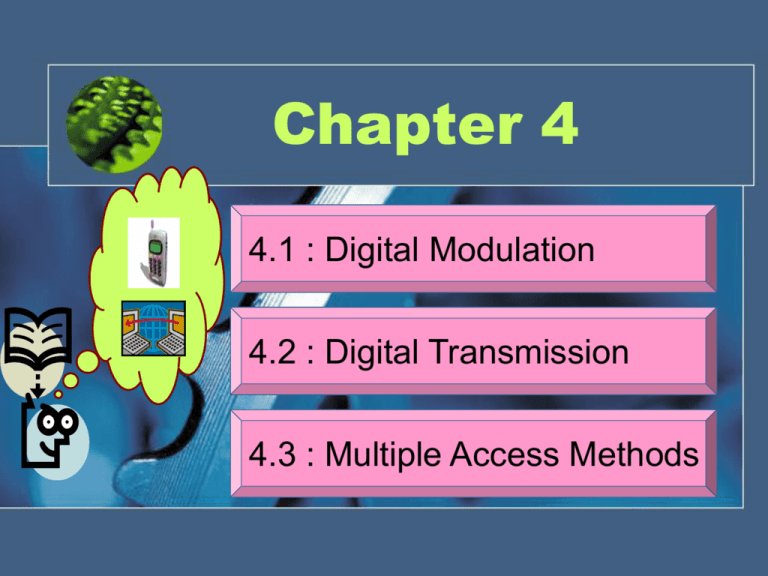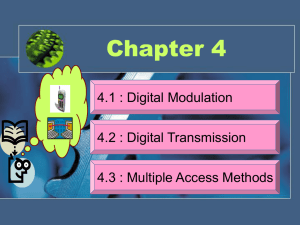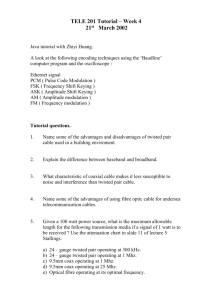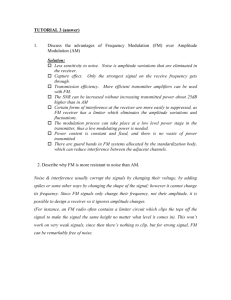Digital Modulation & Transmission Methods
advertisement

Chapter 4 4.1 : Digital Modulation 4.2 : Digital Transmission 4.3 : Multiple Access Methods 4.1 Digital Modulation Outlines a. b. c. Introduction Information capacity, Bits, Bit Rate, Baud, M-ary Encoding Digital Modulation Techniques - ASK, FSK, PSK, QAM Digital modulation • Is the transmittal of digitally modulated analog signals between two or more points in a communications system. • Can be propagated through Earth’s atmosphere and used in wireless communication system - digital radio. • Offer several outstanding advantages over traditional analog system. • Ease of processing • Ease of multiplexing • Noise immunity Cont’d... • Applications: • • • • Low speed voice band data comm. modems High speed data transmission systems Digital microwave & satellite comm. systems PCS (personal communication systems) telephone Why digital modulation? • The modulation of digital signals with analogue carriers allows an improvement in signal to noise ratio as compared to analogue modulating schemes. Important Criteria 1. 2. 3. 4. 5. 6. High spectral efficiency High power efficiency Robust to multipath Low cost and ease of implementation Low carrier-to-co channel interference ratio Low out-of-band radiation Cont’d… 7. 8. Constant or near constant envelop Bandwidth Efficiency • Ability to accommodate data within a limited bandwidth • Tradeoff between data rate and pulse width 9. Power Efficiency • To preserve the fidelity of the digital message at low power levels. • Can increase noise immunity by increasing signal power Forms of Digital Modulation v(t ) V sin( 2ft ) •If the amplitude, V of the carrier is varied proportional to the information signal, a digital modulated signal is called Amplitude Shift Keying (ASK) •If the frequency, f of the carrier is varied proportional to the information signal, a digital modulated signal is called Frequency Shift Keying (FSK) Cont’d… • If the phase, θ of the carrier is varied proportional to the information signal, a digital modulated signal is called Phase Shift Keying (PSK) • If both the amplitude and the phase, θ of the carrier are varied proportional to the information signal, a digital modulated signal is called Quadrature Amplitude Modulation (QAM) Cont’d... Example 1 For the digital message 1101 1100 1010, sketch the waveform for the following: a. ASK b. FSK c. PSK d. QAM Block Diagram Simplified block diagram of a digital modulation system Cont’d… • Precoder performs level conversion & encodes incoming data into group of bits that modulate an analog carrier. • Modulated carrier filtered, amplified & transmitted through transmission medium to Rx. • In Rx, the incoming signals filtered, amplified & applied to the demodulator and decoder circuits which extracts the original source information from modulated carrier. • Information capacity, Bits & Bit Rate – Information capacity is a measure of how much information can be propagated through a communication system and is a function of bandwidth and transmission time. – represents the number of independent symbols that can be carried through a system in a given unit of time. – Basic digital symbol is the binary digit or bit. – Express the information capacity as a bit rate. Hartley’s Law I Bt Where I = information capacity (bps) B = bandwidth (Hz) t = transmission time (s) From the equation, Information capacity is a linear function of bandwidth and transmission time and directly proportional to both. Shannon’s Formula I B log 2 (1 NS ) or I 3.32 B log 10 (1 NS ) Where I = information capacity (bps) B = bandwidth (Hz) S N = signal to noise power ratio (unitless) The higher S/N the better the performance and the higher the information capacity Example 2 By using the Shannon’s Formula, calculate the information capacity if S/N = 30 dB and B = 2.7 kHz. Nyquist Sampling Rate • fs is equal or greater than 2fm fs >= 2fm fs = minimum Nyquist sample rate (Hz) fm = maximum analog input frequency (Hz) Example 3 Determine the Nyquist sample rate for a maximum analog input frequency 7.5 kHz. M-ary Encoding • It is often advantageous to encode at a level higher than binary where there are more then two conditions possible. • The number of bits necessary to produce a given number of conditions is expressed mathematically as N log 2 M Where N = number of bits necessary M = number of conditions, level or combinations possible with N bits. Cont’d… • Each symbol represents n bits, and has M signal states, where M = 2N. Find the number of voltage levels which can represent an analog signal with a. 8 bits per sample b. 12 bits per sample Baud & Minimum BW • Baud refers to the rate of change of a signal on the transmission medium after encoding and modulation have occurred. 1 baud ts Where baud = symbol rate (symbol per second) ts = time of one signaling element @ symbol (seconds) Cont’d… • Minimum Bandwidth – Using multilevel signaling, the Nyquist formulation for channel capacity f b 2 B log 2 M Where fb= channel capacity (bps) B = minimum Nyquist bandwidth (Hz) M = number of discrete signal or voltage levels Cont’d… For B necessary to pass M-ary digitally modulated carriers fb B log M 2 fb N baud Where N is the number of bits encoded into each signaling element. • • • • Amplitude Shift Keying (ASK) Frequency Shift Keying (FSK) Phase Shift Keying (PSK) Quadrature Amplitude Modulation (QAM) Amplitude Shift Keying (ASK) • A binary information signal directly modulates the amplitude of an analog carrier. • Sometimes called Digital Amplitude Modulation (DAM) vask (t ) [1 vm (t )] cos(ct ) A 2 Where vask (t) = amplitude shift keying wave vm(t) = digital information signal (volt) A/2 = unmodulated carrier amplitude (volt) ωc = analog carrier radian frequency (rad/s) Cont’d... Digital Amplitude Modulation A cos(c t ) for logic '1' , vm (t ) 1 vask (t ) for logic '0' , vm (t ) 1 0 Frequency Shift Keying (FSK) • Called as Binary Frequency Shift Keying (BFSK) • The phase shift in carrier frequency (∆f) is proportional to the amplitude of the binary input signal (vm(t)) and the direction of the shift is determined by the polarity v fsk (t ) Vc cos2 [ f c vm (t ) f ]t Where vfsk(t) = binary FSK waveform Vc = peak anlog carrier amplitude (volt) fc = analog carrier center frequency (Hz) ∆f = peak shift in analog carrier frequency (Hz) vm(t) = binary input signal (volt) Vc cos2 [ f c f ]t for logic '1' , vm (t ) 1 v fsk (t ) Vc cos2 [ f c f ]t for logic '0' , vm (t ) 1 f fm fs 2 , where f frequency deviation (Hz) f m f s absolute difference between mark & space frequency (Hz) B ( f s fb ) ( f m fb ) f s f m 2 fb 2(f fb ) Cont’d... Binary Input Frequency Output 0 Space (fs) 1 Mark (fm) Phase Shift Keying (PSK) • Another form of angle-modulated, constant amplitude digital modulation. • Binary digital signal input & limited number of output phases possible. • M-ary digital modulation scheme with the number of output phases defined by M. • The simplest PSK is Binary Phase-Shift Keying (BPSK) – N= 1, M=2 – Two phases possible for carrier with one phase for logic 1 and another phase for logic 0 – The output carrier shifts between two angles separated by 180° Cont’d... a) Truth Table b) Phasor Diagram c) Constellation Diagram Cont’d... BPSK Transmitter Cont’d... BPSK Receiver CONSTELLATION DIAGRAM Definition : A graphical representation of the complex envelope of each possible symbol state. The x-axis represents the in-phase component and the y-axis the quadrature component of the complex envelope The distance between signals on a constellation diagram relates to how different the modulation waveforms are and how easily a receiver can differentiate between them. Cont’d... Cont’d... Quadrature Amplitude Modulation (QAM) • Combine amplitude and phase-shift keying. • Method of voice band data transmission. • QAM = 4-PSK Cont’d... Cont’d... Cont’d... • Amplitude and phase shift keying can be combined to transmit several bits per symbol. – Often referred to as linear as they require linear amplification. – More bandwidth-efficient, but more susceptible to noise. • For M = 4, 16QAM has the largest distance between points, but requires very linear amplification. 16PSK has less stringent linearity requirements, but has less spacing between constellation points, and is therefore more affected by noise. • High level M-ary schemes (such as 64-QAM) are very bandwidth-efficient but more susceptible to noise and require linear amplification Bandwidth Efficiency – Used to compare the performance of one digital modulation technique to another. Bη = Transmission bit rate (bps) Minimum bandwidth (Hz) Example 5 For 16-PSK system, operating with an information bit rate of 32 kbps, determine: a. Baud b. Minimum bandwidth c. Bandwidth efficiency • • • • • Solution: 16PSK= log2(M) a) baud= 32000/4=8000 b) minimum bandwidth = 32000/4 =8000 c)Bandwidth efficiency =transmission bit rate/minimum bandwidth= 32000/8000=4 bits per cycle CONCLUSION • To decide which modulation method should be used , we need to make considerations of a) b) c) Bandwidth Speed of Modulation Complexity of Hardware




